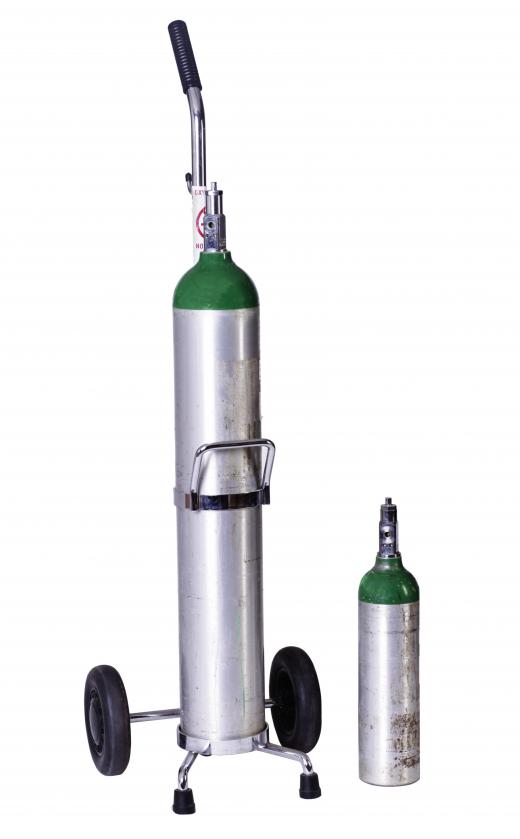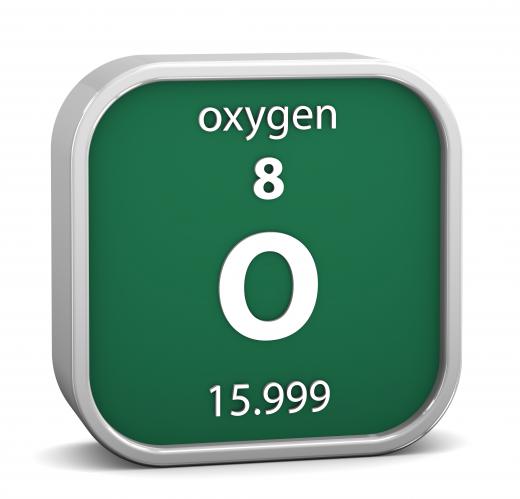What is Oxygen?
 Mary McMahon
Mary McMahon
Oxygen is a colorless, odorless, tasteless gaseous chemical element which appears in great abundance on Earth, trapped by the atmosphere. Many people are familiar with oxygen, because it is a vital component of the respiration process; without it, most organisms will die within minutes. A number of forms of oxygen and its compounds can be found in nature. The gas can also be isolated and sold in pure form for an assortment of uses, and was first isolated and identified in 1774.
The atomic number of oxygen is eight, and it is identified by an O symbol on the periodic table of elements. In addition to being very widely distributed on Earth, it is also the third most abundant element in the universe, and it is a key catalyst in many chemical reactions. Oxidation is one such reaction, and it occurs when it mixes with other elements and compounds. Oxygen also plays a role in combustion.

There are several ways to extract pure oxygen. Water can be ionized, forcing the oxygen and hydrogen atoms to separate. More commonly, however, samples of air are cooled into a liquid form and then slowly heated. As the air heats, elements precipitate out in a process called fractional distillation, because different gaseous elements convert to a gas form at different temperatures. Once extracted, the gas can be bottled for use.

In medicine, oxygen has a number of uses. It is sometimes offered therapeutically to patients who are having difficulty breathing. It is also used in anesthesia mixtures, ensuring that the patient gets a consistent supply of the gas while unconscious. The element also plays a role in welding and industry, being combined with substances like acetylene, for example, to make welding torches.

Although pure oxygen is used medicinally and recreationally, as it brings about a state of mild euphoria, it is potentially dangerous. In high pressure environments, toxicity from overuse can damage the lungs, often quite severely. Depending on the pressure, symptoms may emerge right away, or they may take several hours to manifest, at which point it can be too late. The gas also represents a serious combustion hazard, and some compounds such as ozone and hydrogen peroxide are extremely toxic. These compounds can damage cells and DNA if they are left unchecked. Living organisms should consume a diet high in antioxidants to help avert one form of this damage, caused by free radicals in the body.
AS FEATURED ON:
AS FEATURED ON:
















Discussion Comments
What is oxygen used for?
Why is oxygen such a reactive element?
Why do we breathe in oxygen?
Oxygen is not dangerous.
Oxygen concentrators are quite amazing. They help so many people with respiratory problems by concentrating air with oxygen and delivering it to them. The best part of that is that now those who couldn't go out and do things because they were confined to their home are now able to get out and move around and do the things that they weren't able to do before. I love it. Technology is amazing.
how does oxygen deal with our blood?
how many experiments can you do with oxygen?
what is oxygen most commonly found in or used for?
Where can oxygen be found?
what are molecules and atoms?
why can't you see or taste oxygen?
why is oxygen not seen?
oxygen is healthful to people.
where do gases come from?
carbon dioxide is a greenhouse gas.
hydrogen with small amount of helium is in the sun.
the sun is a star (closest star to Earth).
why can oxygen not be seen?
what is oxygen used for?
what uses could oxygen have when on a different planet?
Is oxygen dangerous?
oxidation process is harmful or not?
Does everyone have cancer?
Is oxygen flammable
how does oxygen work?
what are the first most abundant elements of the universe? i'm just wondering... this site is useful thanks :)
What types of ions is oxygen likely to form?
Post your comments